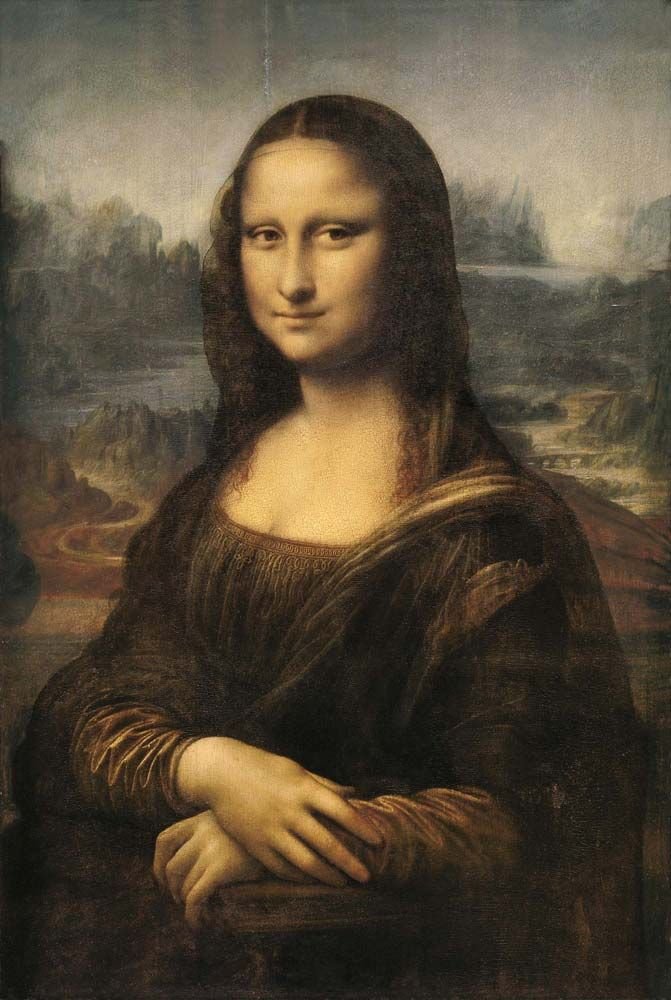The Mona Lisa (/ˌmoʊnə ˈliːsə/ MOH-nə LEE-sə; Italian: Gioconda [dʒoˈkonda] or Monna Lisa [ˈmɔnna ˈliːza]; French: Joconde [ʒɔkɔ̃d]) is a half-length portrait painting by Italian artist Leonardo da Vinci.
Mona Lisa from Francis 1 invitation settle at his court "Giocondo", which is probably dedicated to del Giocondo's wife. Leonardo is so stunned by the woman's beauty that he wants her portrait to be like life During this period of intensive work, Leonardo draws a lot, takes notes and invents new mechanisms. In 1503, he began his most famous painting - in the French town of Amb Leonardo is accepted at the settlement royal artist, etc and architect", but in reality Francis just wanted to eat 3 Leonardo on various topics.
THE MYSTERY OF GIOCONDI
The origin of the painting that Leonardo completed in France has always been shrouded in mystery. Invent an exciting story where the main characters will be Leonardo, Mona Lisa and you in the role of a master's student. Add one bad character and someone who will help the heroes Now you have everything you need to create a mysterious.
The Mona Lisa and its influence
The influence of the Mona Lisa on the Renaissance and later times has been enormous, revolutionizing contemporary portrait painting. Not only did the three-quarter pose become the standard, but also Leonardo’s preliminary drawings encouraged other artists to make more and freer studies for their paintings and stimulated connoisseurs to collect those drawings. Through the drawings, his Milanese works were made known to the Florentines. Also, his reputation and stature as an artist and thinker spread to his fellow artists and assured for them a freedom of action and thought similar to his own. One such painter was the young Raphael, who sketched Leonardo’s work in progress and adopted the Mona Lisa format for his portraits; it served as a clear model for his Portrait of Maddalena Doni.
10 Facts You Might not Know about the Masterpiece
1. She lived with Francois I, Louis XIV and Napoleon
Although da Vinci began work on his masterpiece while living in his native Italy, he did not finish it until he moved to France at King Francois I's request. The French king displayed the painting in his Fontainebleau palace where it remained for a century. Louis XIV removed it to the grand Palace of Versailles. At the outset of the 19th century, Napoleon Bonaparte kept the painting in his boudoir.
2. Some historians believe Mona Lisa is a Self-Portrait of Leonardo da Vinci.
Leonardo da Vinci died in 1519, and he is buried at a French castle. Italy's National Committee for Cultural Heritage is undertaking an investigation, and plans to dig up his skull. They want to rebuild Leonardo's face, using CSI-style technology. Will he resemble the mysterious Mona Lisa?
3. She has her own room in the Louvre Museum in Paris.
After the Louvre launched a four-year, $6.3 million renovation in 2003, the painting now has its own room. A glass ceiling lets in natural light, a shatter-proof glass display case maintains a controlled temperature of 43 degrees F. and a little spotlight brings out the true colors of da Vinci's original paints.
4. It is a painting but not a canvas.
Da Vinci's famous masterpiece is painted on a poplar plank. Considering he was accustomed to painting larger works on wet plaster, a wood plank does not seem that outlandish. Canvas was available to artists since the 14th century, but many Renaissance masters preferred wood as a basis for their small artworks.
5. Jackie Kennedy invited her to visit.
Over the centuries, French officials have only rarely let the painting out of their sight. However, when first lady Jackie Kennedy asked if the painting could visit the U.S., French President de Gaulle agreed. "Mona Lisa" went on display at the National Gallery of Art in Washington D.C. and then at the Metropolitan Museum of the Arts in New York City.
6. A thief made her famous.
Although in the art world, the painting had always been an acknowledged masterpiece, it wasn't until it was stolen in the summer of 1911 that it would capture the attention of the general public. Newspapers spread the story of the crime worldwide. When the painting finally returned to the Louvre two years later, practically the whole world was cheering.
7. Picasso was under suspicion for the theft. During the investigation, the gendarmes went so far as to question known art dissidents such as Pablo Picasso about the theft. They briefly arrested poet Guillaume Apollinaire, who had once said the painting should be burned. Their suspicions proved to be unfounded.
8. She receives fan mail.
Since the painting first arrived at the Louvre in 1815, "Mona Lisa" has received plenty of love letters and flowers from admirers. She even has her own mailbox.
9. Not everyone is a fan.
Various vandals have tried to harm da Vinci's famed masterpiece, and 1956 was a particularly bad year. In two separate attacks, one person threw acid at the painting, and another individual pelted it with a rock. The damage is faint but still noticeable. The addition of bulletproof glass repelled subsequent attacks with spray paint in 1974 and a coffee cup in 2009.
10. She cannot be bought or sold.
Truly priceless, the painting cannot be bought or sold according to French heritage law. As part of the Louvre collection, "Mona Lisa" belongs to the public, and by popular agreement, their hearts belong to her.
📕 THINK LIKE LEONARDO DA VINCI - Carlo Karzan Sonya Scalco
Wikipedia
britannica
leonardodavinci.net